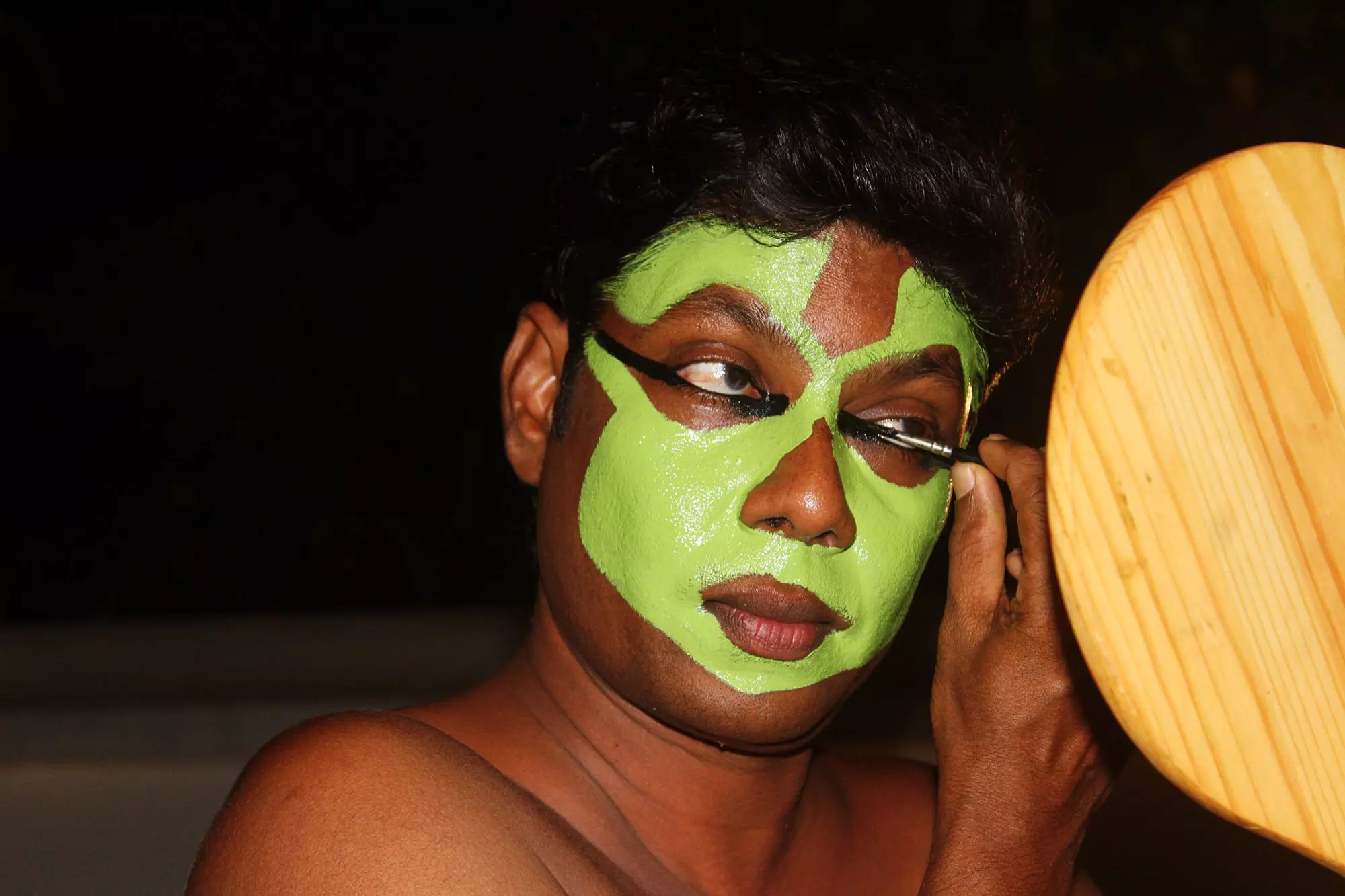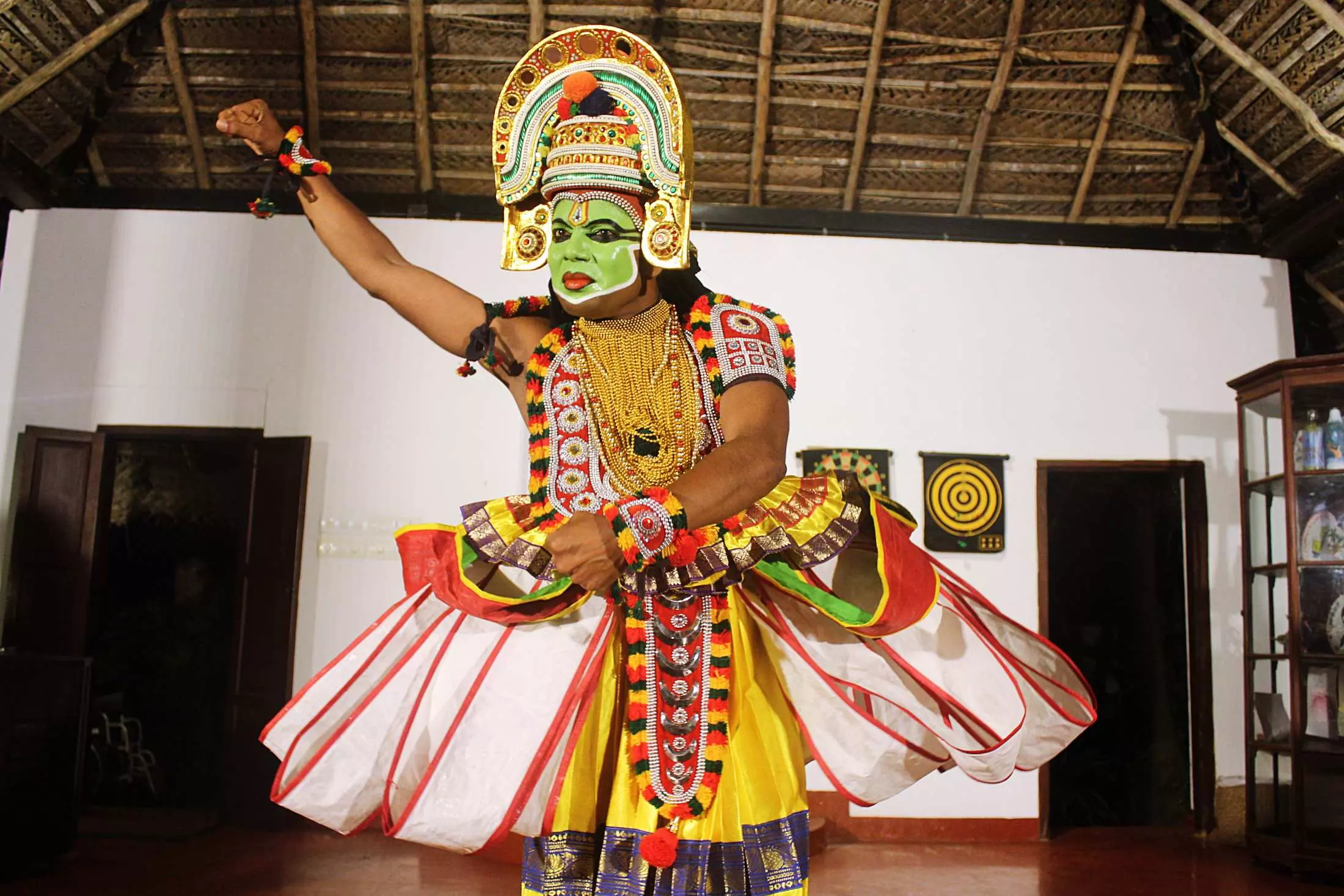
- Home
- India
- World
- Premium
- THE FEDERAL SPECIAL
- Analysis
- States
- Perspective
- Videos
- Sports
- Education
- Entertainment
- Elections
- Features
- Health
- Business
- Series
- In memoriam: Sheikh Mujibur Rahman
- Bishnoi's Men
- NEET TANGLE
- Economy Series
- Earth Day
- Kashmir’s Frozen Turbulence
- India@75
- The legend of Ramjanmabhoomi
- Liberalisation@30
- How to tame a dragon
- Celebrating biodiversity
- Farm Matters
- 50 days of solitude
- Bringing Migrants Home
- Budget 2020
- Jharkhand Votes
- The Federal Investigates
- The Federal Impact
- Vanishing Sand
- Gandhi @ 150
- Andhra Today
- Field report
- Operation Gulmarg
- Pandemic @1 Mn in India
- The Federal Year-End
- The Zero Year
- Science
- Brand studio
- Newsletter
- Elections 2024
- Events
Why Ottanthullal, a 300-year-old satirical dance-drama from Kerala, is a declining art today
Founded by 18th-century poet Kunchan Nambiar, Ottanthullal uses wit, rhythmic verse and energetic dance to critique social evils like corruption, hypocrisy and caste oppression. Today, there are few interested in keeping the form going, however, as investments appear to outweigh returns

Maruthorvattom Kannan sat hunched on a black plastic chair in a dimly-lit backstage space at Coconut Lagoon, a heritage property at Kumarakom, Kerala, last month. A combination of aromas drifted around him — of coconut oil, chalky powder, pigment ground fine, blended with the wet-earth smell wafting in from outside. His costume — a single kirida (crown), pavada (lower garment) and...
Maruthorvattom Kannan sat hunched on a black plastic chair in a dimly-lit backstage space at Coconut Lagoon, a heritage property at Kumarakom, Kerala, last month. A combination of aromas drifted around him — of coconut oil, chalky powder, pigment ground fine, blended with the wet-earth smell wafting in from outside. His costume — a single kirida (crown), pavada (lower garment) and kachchamani (ankle bells) — were folded nearby, bright with embroidered threads and mirror work. He mixed green pigment made from maniola and katta neela stones with coconut oil and sugar. His fingers trembled slightly with the effort as he precisely and expertly blended them in until the green was just right and applied it on his face. Next, he drew a few lines with zinc white, put a dab of red powder at the lips, dark kajal around his eyes. “This,” he said, “is my transformation. Half-an hour if [the look] is simple, sometimes one full hour. But over forty years of doing this makes each brush-stroke count.”
Born in Maruthorvattom, near Alappuzha (Cherthala), 46-year-old Kannan was drawn to classical music and dance early. He was just three years old, as he recalled, when his interest in classical dance was triggered and a year later, at four, he began his formal training in Ottanthullal, a 300-year-old satirical form of dance-drama in Kerala, under guru Vylar Krishnan Kutty. Ottan means to run or leap in Malayalam, while thullal means dancing or jumping in rhythm.
Ottanthullal was founded by Kunchan Nambiar, a prominent 18th-century Malayalam poet. The art form is believed to have been born from pride, anger, and satire. The story goes that Nambiar, drumming for a Chakyar Koothu act, a solo performance centred around a monologue, once fell asleep; when mocked, he created a form that would mock back, that would use humour and local language to speak truth to tradition. It was not bound to temple walls. It was of the people. It spoke in Malayalam, with poetry, satire, song, and dance. It carried both enjoyment and reflection.
Kannan often lets this origin story hover around his performance. His training under Vailarkrishnan Kutty shaped him. The discipline instilled in him from early childhood has put attention to the classical ragas, the perfection of the mudras [hand gestures], the nine rasas [emotions depicted], the dialogue between movement and voice, at the core of his performance. But within that core, there is room for improvisation, for humour, for adaptation.
His stage debut had come almost immediately after he started training. The green face, crown and bells that form his costume, were not just the trappings of his profession, but his very identity as an artiste.
At Coconut Lagoon last month, as the curtains rose, Kannan strode onto stage, opening his act with “Kalyana Saugandhikam,” one of the earliest Ottanthullal tales from the Mahabharata, in which Bhima sets out to find the rare, sweet-scented Saugandhikam flower for Draupadi.
His voice, robust, sang the poem; hands, eyes, feet moving in sharply defined mudras. One moment he was Bhima, the strong; the next, a Draupadi in pain and then a clownish messenger mocking the greedy or arrogant. All in the leap of a gesture, glint of an eye. The white lines at his brow cut in sharp relief against the green base; when his foot struck the floor, it echoed, laughter burst from the audience when he teased them, drawing them in, making them complicit in the performance.
Also read: How the popularisation of Dakla music led to its traditional folk artistes being sidelined
To Jose Anto Kattukkaran, who had been among the audience, Kannan “looked like he was running on myth itself. And the myth was alive”.
Teresa Good, who had been visiting Kerala from the US, admitted that at first she had thought Ottanthullal meant costume and funny gestures, but by the end, realised she and her husband had been sitting through poetry, history, class, satire — more than entertainment.
Performing Kalyana Saugandhikam in that one costume, no wardrobe change, just the shifting in characters through voice and expression modulation, shows the tradition’s brilliance. Kannan’s hands articulated the 24 mudras used in Ottanthullal, while the nine rasas (love, heroism, comic, pathos, disgust, anger) fleeted across his face in keeping with the act. He sang in classical ragas — Revagupti, Nata, Bhubalam, among them — as the drums (mridangam) kept the beat to his rhythmic stamping, the leaps and jumps — all fused into one spectacular performance.

Maruthorvattom Kannan applies makeup ahead of a show. Photo: Veidehi Gite
“Ottanthullal assigns a central role to verbal expression. In performances for Malayalam-speaking audiences, the meaning of the verses, along with their embedded satire, is communicated effectively through the poetic lines themselves. In such contexts, while facial expressions remain important, equal emphasis is placed on the semantic and rhetorical force of the verses,” said Kalamandalam Prabhakaran, another veteran performer, who had completed a diploma course in Thullal at the Kerala Kalamandalam, a deemed-to-be-art and culture university, in 1964.
For Prabhakaran, the most important aspect of the form was that it “served as a cultural instrument of social critique, functioning as a weapon against prevailing social evils and seeking to eradicate them through satire and performance”.
According to Ottanthullal performers, Nambiar used mythic set-pieces from Mahabharata as a vehicle to mock the people, power structures, social norms such as caste snobbery, corrupt officials, predatory landlords and hypocrisy by the pious. In Kalyāna Saugandhikam, for example, Nambiar’s treatment turns Bhīma into a figure whose foibles are mocked; through his buffoonery, the performer ridicules prideful warriors, incompetent administrators and the hypocrisy of bragging nobles. This is frequently cited as a classic example of myth-satire by Ottanthullal performers.
Kannan talks of humour as the bone, not ornament of Ottanthullal; of satire that must still carry respect; of movements inspired by martial arts—not for violence, but for energy. He remarked how while Kathakali, Koothu, and many other arts in Kerala shared footwork, body disciplines and physical stamina, in Ottanthullal the performer must also be a comedian, poet, storyteller in one.
Also read: How Purulia’s Chhau dance is changing, and what it’s losing along the way
But beneath the leaps and the laughter, lies fragility. Though often called the poor man’s Kathakali, staging an Ottanthullal still costs a fair bit — costumes alone can eat up the budget. Kannan speaks openly about what it takes to keep going. “Costumes cost, crowns cost. The crown alone can be around Rs. 50,000; full costumes Rs. 40,000. Materials cost, craftspeople cost; repairs are frequent. After about 10-15 performances, a costume begins to wear; tears are patched or replaced,” he says. Makeup takes time and skill; natural pigments must be procured; stones must be ground and mixed. Travel, stage set-up, lights, sound —all must be arranged. Frequently, Kannan said, he pays out of his own pocket.

One of the many moods of Maruthorvattom Kannan during a performance. Photo: Veidehi Gite
Money received for shows varies wildly. A half‑hour set at a small show or local fair brings in just Rs. 10,000, but the price jumps to around Rs. 1 lakh for big festivals, international tours, or high‑profile stages, Kannan added. But which shows arrive, how often, under what terms, is unpredictable.
The performer claims cultural festivals may favour more mainstream classical dance forms, while government grants and institutional support are patchy. Despite being uniquely expressive and historically deep, Ottanthullal receives less attention from funding agencies than more glamorous or well-known art forms. Moreover, learning the full repertoire, mudras and rasas, requires time, patience, discipline. Younger students who sign up for workshops must be committed; many drop out because the investment seems too large compared to perceived returns, Kannan explained. According to insider estimates, there are only around 200 practicing Ottanthullal performers left worldwide.
MV Narayanan, former vice chancellor, Kerala Kalamandalam, argued, however, “Ottanthullal has received its fair share of recognition in terms of support and funding—which is not much, but it is there”. The real problem, according to him, lies in the fact that Ottanthullal failed to activate or excite audiences after the 1900–1950s. He added: “By that time, what we find is that Ottanthullal came to be used as a form for political campaigning — during elections, for social causes, and for very contemporary issues. But all of these were limited to their immediate, narrow concerns, without reference to later or broader contexts.”
While Ottanthullal is still taught in Kalamandalam and a number of other institutions, and is performed at some venues—at least in temple festivals and in different kinds of performative festivals — as a form, it does not seem to have the same kind of appeal or command that Kathakali has, or even Koodiyattam (another traditional performing art in Kerala), said Narayan, which, though it has only a minuscule audience, retains a deeply committed one. “Even when Ottanthullal is used these days, it is more as a reminder of what it once was, or as a redeployment of the form for contemporary social or political purposes—which tend to have a very limited shelf life, so to speak,” he added.
Perhaps conscious of this, performers like Kannan, while still holding to classical repertoire, are evolving to cater to audiences that may not know the stories. Non-Malayali tourists, diaspora Malayalis and younger audiences who consume performance art online. To reach them, artistes sometimes preface performances with summaries, translate or explain myth, slow certain sections, highlight facial expressions so that non-Malayalam speakers can follow. Prabhakaran and Kannan do this; so do others.
Also read: Ayyappan Theeyattu, Kerala’s ritualistic theatre form, opens its doors to a female artist
Globally, Ottanthullal has been staged in the UK, Dubai and festivals abroad, say performers. These bring not only payment but cross-cultural exposure, critical feedback. The costume, makeup, duration must often be adapted for foreign stages, for time constraints, for different audience expectations. But the core remains: the solo artist, the poem, the shift in character, the wit.
After the performance at Coconut Lagoon, Kannan removed the crown, wiped off the green paint, folded costume pieces carefully, inspecting seams and bells. It is the end of the night, but not the end of work. The artiste embodies Ottanthullal’s paradox: ancient yet alive; disciplined yet humorous; mythic yet immediate. “I live only for this art form. I need to spread my art form through me,” said Kannan.
(With inputs from Rajeev Ramachandran in Kerala)
